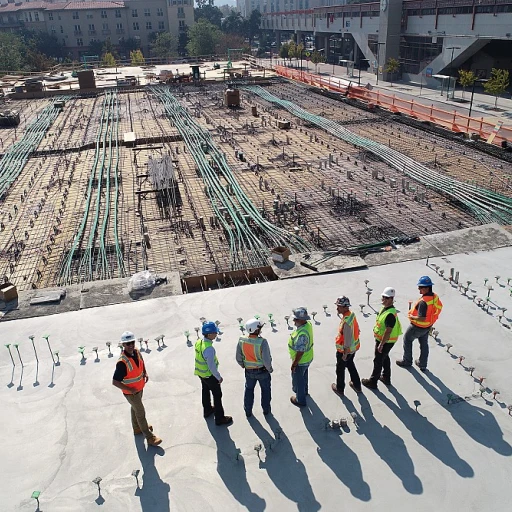
Understanding the Role of Drafter Interview Feedback Forms
Why Feedback Forms Are Essential in the Recruitment Process
The recruitment process can be quite complex, with the ultimate goal to find the best fit for the job and the organization. To aid in this, drafter interview feedback forms serve as a critical tool in evaluating a candidate's performance during interviews. These documents help hiring managers systematically assess the skills, experience, and potential areas for improvement for each candidate, ensuring a comprehensive view of their compatibility with the role. Feedback forms are particularly beneficial in structured interviews, providing a standardized method for interviewers to document their assessment of interview questions and the candidate's problem-solving capabilities. They allow for objective evaluation, minimizing biases that could arise from informal assessments. Moreover, using a feedback form can significantly enhance the candidate experience. After all, formal feedback from the interview process can offer valuable insights to candidates on their strengths and areas for further development. When properly utilized, these forms contribute to a more efficient hiring process, facilitating quicker decision-making while promoting transparency and fairness. For more insights on how to effectively conduct interviews and assess candidates, check out our detailed guide on essential interview questions for estimator roles.Key Components of an Effective Feedback Form
Essential Elements for Interview Feedback Forms
Creating an interview feedback form that effectively assesses candidates involves several key components. Making sure your feedback form includes these elements can significantly enhance the recruitment process and improve the quality of your hire.- Candidate Information: This includes basic details such as the name, job position, and the date of the interview. Keeping this information at the top is crucial to ensure all evaluators are focused on the correct candidate.
- Interview Questions & Evaluation Criteria: The form should list the key interview questions asked and provide space to rate the candidate's responses. Including a scoring system helps in making the process more standardized. This section should also cover the evaluation form with criteria aligned to the job requirements, ensuring evaluators assess relevant skills and competencies.
- Performance Metrics: Consider defining what performance means for the role. Include checkboxes or scales that reflect how well the candidate meets job-related skills and competencies.
- Areas for Improvement: Providing a place to note where the candidate might improve allows recruiters to weigh potential and training needs when making hiring decisions.
- Overall Assessment and Recommendations: This should include a section for the overall interview assessment providing a summary of the candidate's potential fit within the company. It can guide hiring managers in their decision-making.
- Space for Additional Comments: Open-ended sections allow interviewers to provide qualitative feedback that may not be captured through quantitative scores.
- Feedback Collection Modalities: Flexibility is key, so consider how feedback is collected, whether through digital formats or traditional paper. This can aid in streamlining the feedback process.
Common Challenges in Implementing Feedback Forms
Addressing Common Roadblocks in Feedback Form Usage
Implementing drafter interview feedback forms can be a game-changer in streamlining the hiring process, yet it's not without its challenges. Understanding these hurdles can help organizations navigate toward more effective feedback collection and utilization. Here are some key obstacles often encountered in this space:
- Lack of Standardization: One common issue is the absence of a standardized framework for feedback forms across different interviews. Without a consistent template, comparing evaluation metrics becomes difficult, which may lead to subjective and variable assessments of candidate performance.
- Time Constraints: Hiring managers and human resources personnel often face time pressures, which can lead to rushed and incomplete feedback documents. This compromises the quality of the input collected and ultimately affects decision-making processes.
- Unsuitable Questions: Interview questions that do not align with the role-specific skills and the job description can render feedback forms ineffective. This misalignment creates gaps in the evaluation of candidate capabilities and potential areas for improvement.
- Difficulty in Analyzing Feedback: Even with collected data, extracting actionable insights from feedback forms can be challenging. Many firms struggle with integrating this data into a coherent analysis that informs their recruitment process.
Overcoming these barriers requires strategic management and investment in effective feedback practices. Leveraging advanced tools for collecting and analyzing feedback is oftentimes a significant step forward, helping organizations to harness technology for more refined hiring processes.
Best Practices for Gathering and Utilizing Feedback
Effective Collection and Usage Tactics
In order to maximize the benefits of drafter interview feedback forms, it's crucial for organizations to adhere to a set of best practices. The techniques not only ensure the effective gathering of feedback, but also enhance the subsequent analysis. A structured and thoughtful approach contributes significantly to the overall hiring process, ultimately improving the candidate experience and the quality of hires.
Facilitating Clear, Structured Interviews
One of the most impactful methods for gathering actionable feedback is to ensure that the interviews themselves are well-structured. By using a consistent interview evaluation form across candidates, hiring managers can assess skills and performance systematically. Structured interviews with pre-defined interview questions help avoid biases and enhance the comparability of different candidates. This results in more objective assessments that are critical for effective decision-making.
Standardizing Feedback Forms
A standardized feedback form is a powerful tool in your recruitment arsenal. A template with sections for various competencies and areas for improvement allows interviewers to provide consistent and comprehensive feedback. Borrowing elements from an effective interview guide for tech hiring can enhance your form, ensuring it covers all critical aspects of a candidate's evaluation.
Training Hiring Managers
An often overlooked aspect of gathering useful feedback is investing in training for hiring managers. Training sessions can enhance interviewers' abilities to assess candidates objectively and record insightful feedback. This approach not only improves the quality of the feedback but also provides interviewers with the skills necessary for effective recruitment management.
Timely Completion and Review
The timing of feedback collection is another critical factor. Feedback forms should be filled out promptly after interviews while the interaction is still fresh in the interviewer’s mind. This practice ensures accuracy and detail in the feedback, contributing to a more robust assessment form that aligns with the overall recruitment process.
Implementing these best practices helps organizations not only capture detailed candidate data but also utilize it effectively for improving talent acquisition strategies and enhancing overall employee performance post-recruitment.
Leveraging Technology to Streamline Feedback Collection
Integrating Technology for Seamless Feedback Collection
Incorporating technology into your recruitment process can significantly enhance the efficiency of gathering and utilizing interview feedback for drafter positions. Leveraging digital tools ensures a structured and streamlined approach to collecting valuable insights from interviews, improving both candidate experience and decision-making quality. First and foremost, implementing an online interview feedback form allows hiring managers to easily document their evaluation of candidate skills and performances. This digital form can serve as a template for all interviewers, standardizing the feedback collection process and promoting a fair assessment across candidates. Using software solutions for feedback capture offers several benefits:- Centralized Data Collection: A digital document allows for the centralization of feedback from multiple interviews, which can facilitate better tracking of candidate performance over time.
- Ease of Access and Sharing: An online feedback form can be easily accessed by everyone involved in the hiring process. This simplifies the collaboration among recruitment teams and human resources, making it easier to compare notes on candidate evaluations.
- Automated Analysis: Many tech solutions provide analytics tools that can summarize and analyze feedback data. This feature aids hiring managers in identifying patterns and areas for improvement within the hiring and interview processes.
- Streamlined Decision Making: With comprehensive feedback readily available, decision-making regarding candidate hiring becomes more informed and timely. This reduces the time between interviews and final recruitment decisions.







